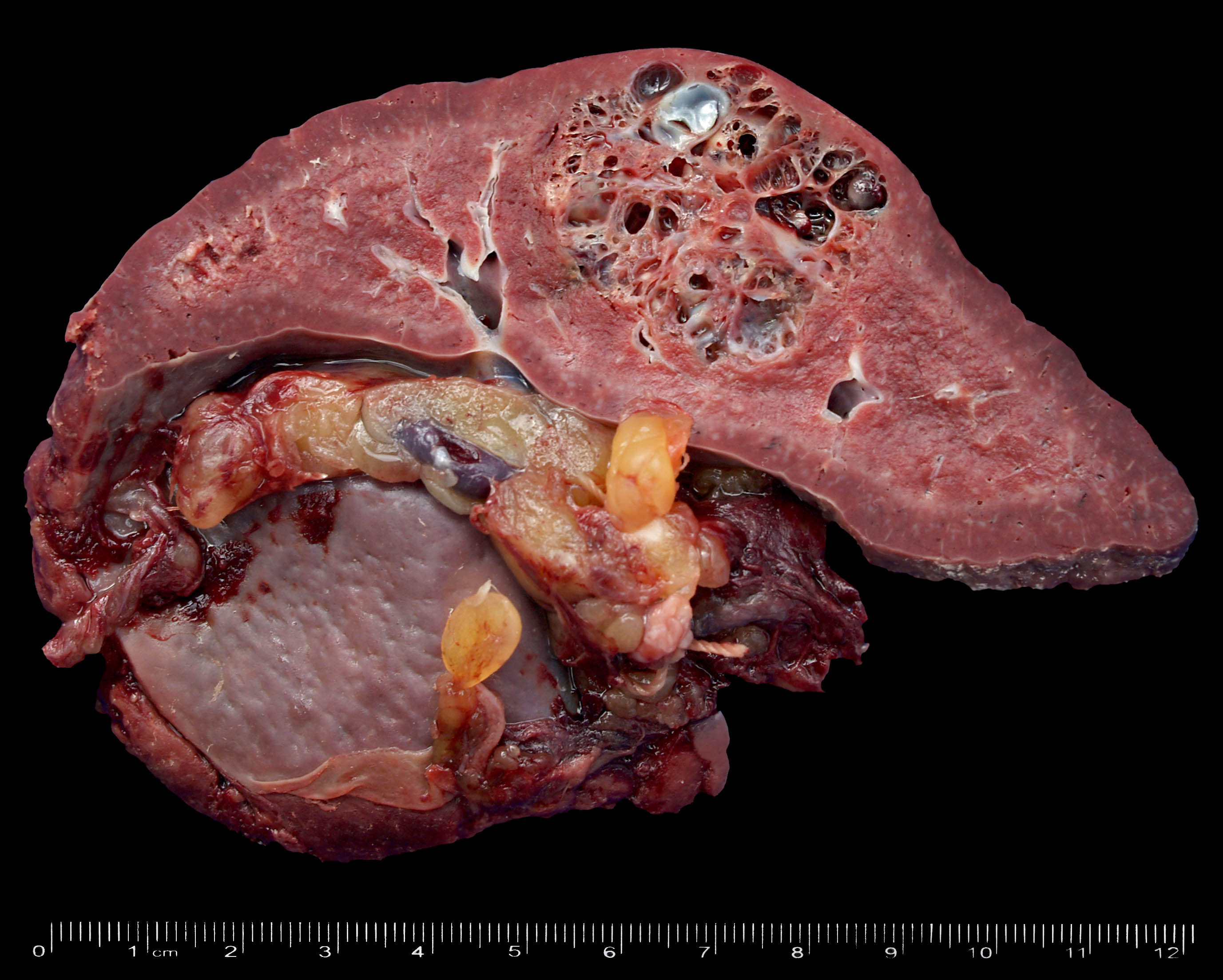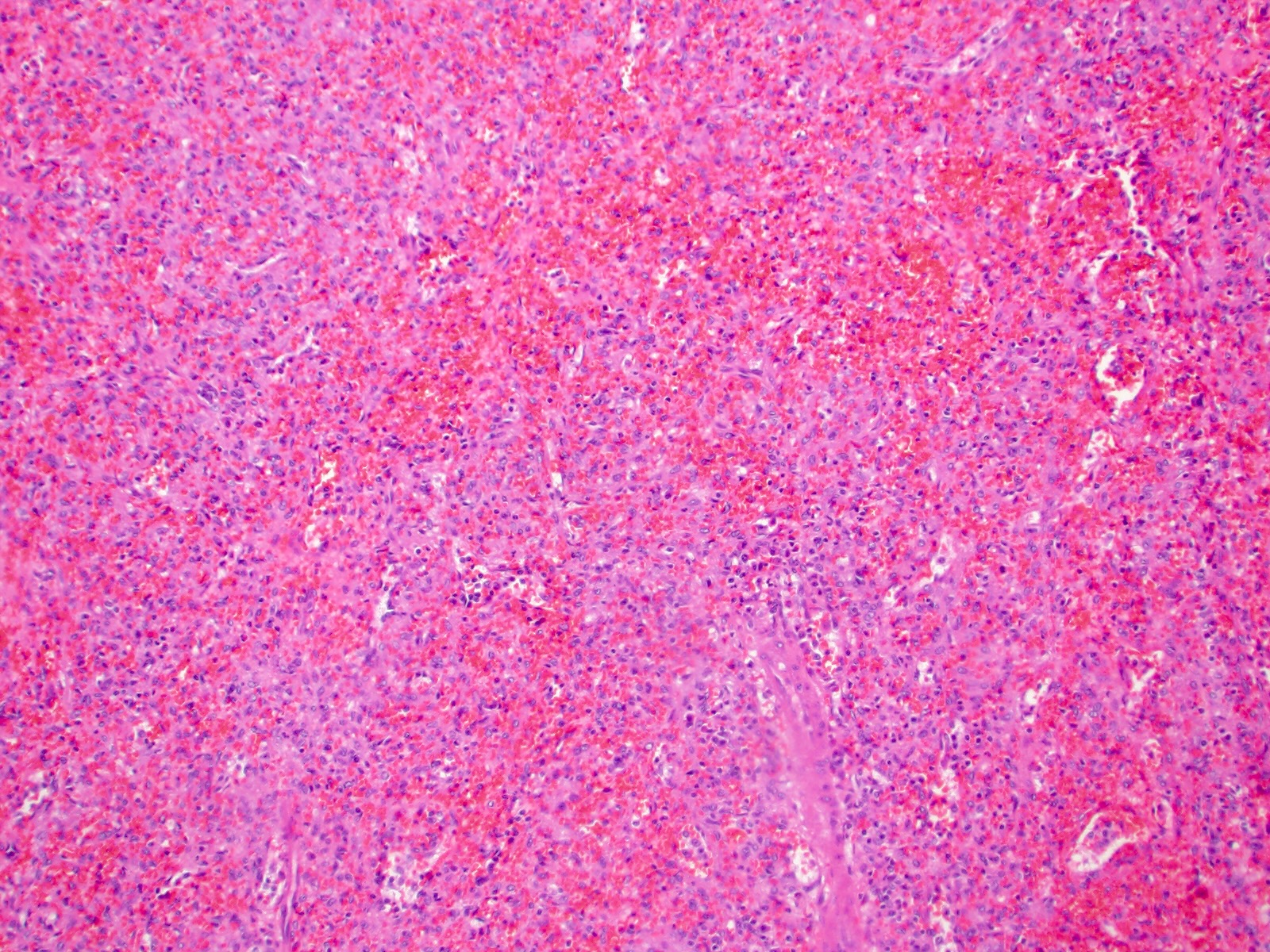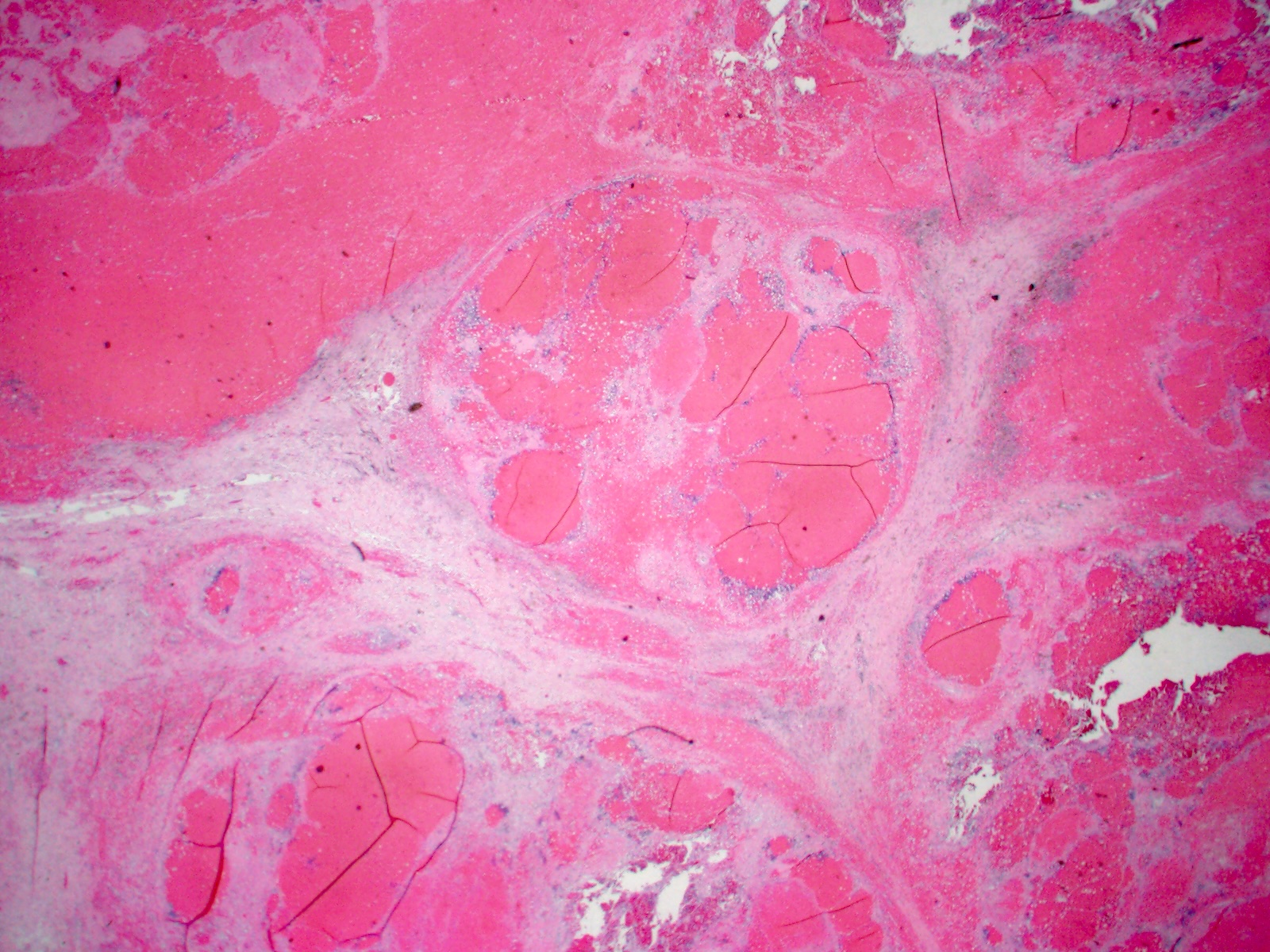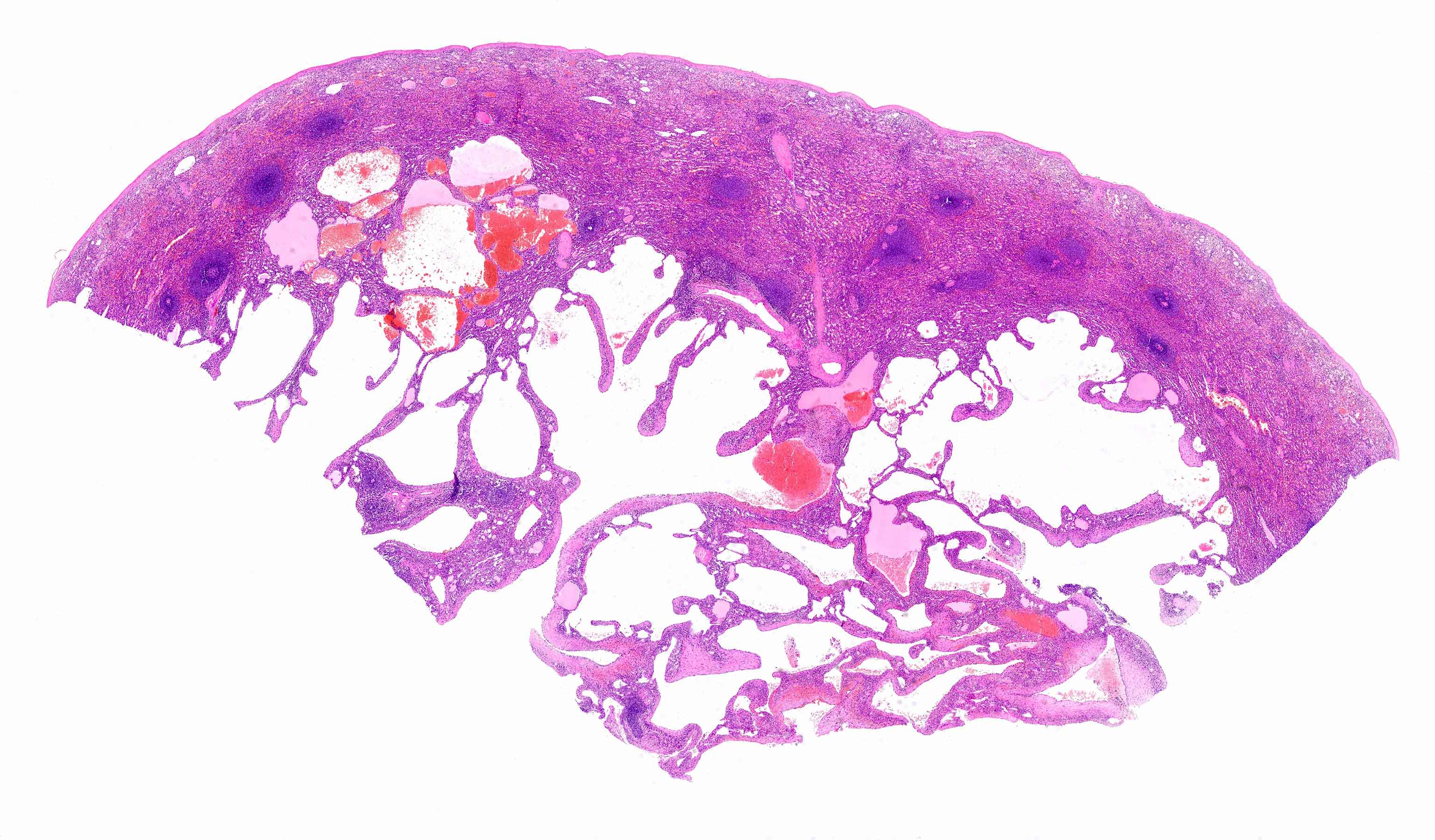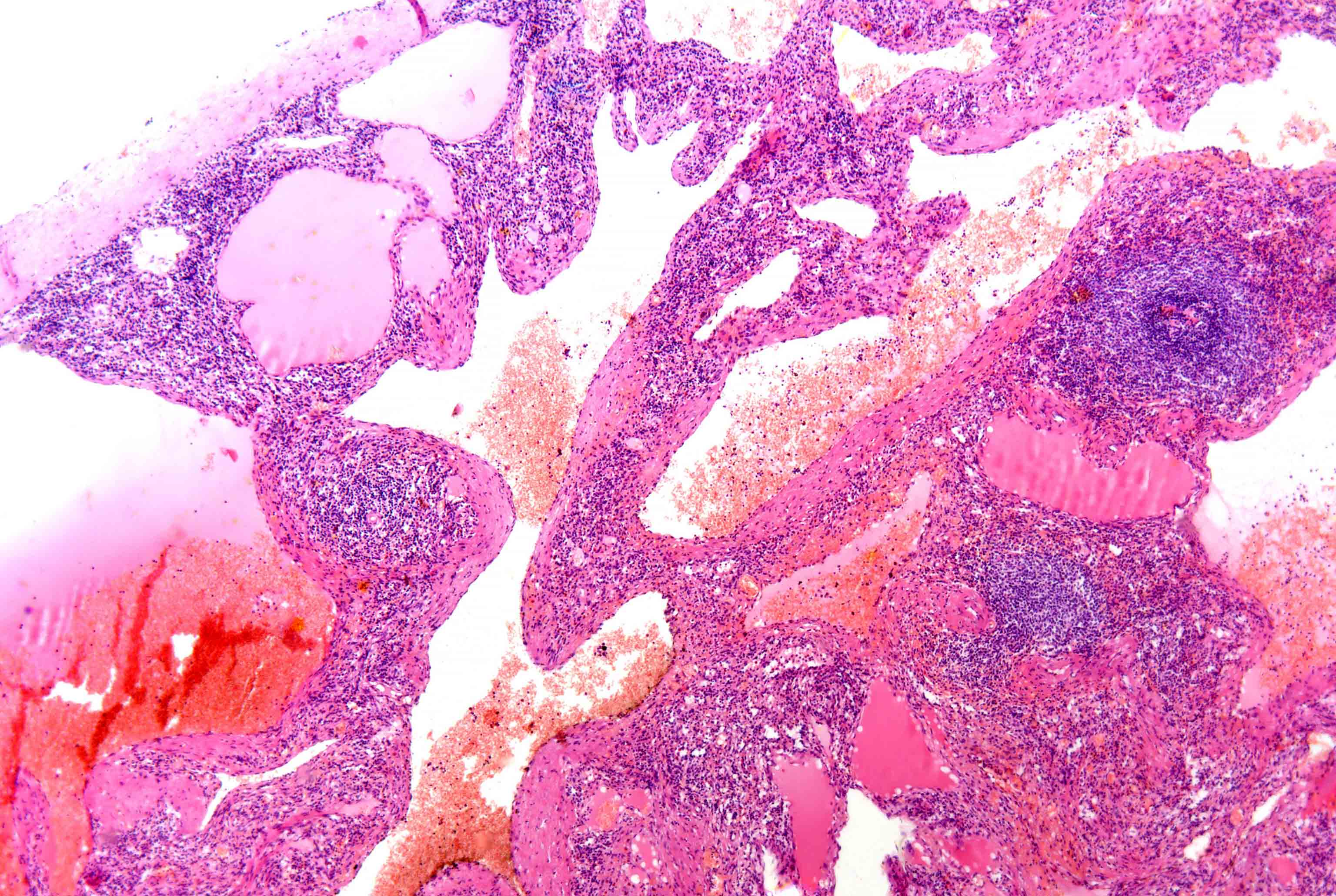Table of Contents
Definition / general | Essential features | Terminology | ICD coding | Epidemiology | Pathophysiology | Etiology | Clinical features | Diagnosis | Laboratory | Radiology description | Radiology images | Prognostic factors | Case reports | Treatment | Gross description | Gross images | Microscopic (histologic) description | Microscopic (histologic) images | Cytology description | Positive stains | Negative stains | Molecular / cytogenetics description | Sample pathology report | Differential diagnosis | Additional references | Board review style question #1 | Board review style answer #1 | Board review style question #2 | Board review style answer #2Cite this page: Danielson D, Schmieg J, Auerbach A. Hemangioma-spleen. PathologyOutlines.com website. https://www.pathologyoutlines.com/topic/spleenhemangioma.html. Accessed April 2nd, 2025.
Definition / general
- Splenic hemangioma is a benign splenic lesion that is typified by the proliferation of variable sized blood vessels lined by bland endothelial cells
- Most common benign splenic tumor
Essential features
- Typically an asymptomatic, incidentally discovered splenic vascular lesion
- Vascular channels are lined by a single layer of flat to plump endothelial cells without atypia or significant mitosis
- Endothelial cells will stain positive for vascular markers and negative for histiocytic markers
Terminology
- Hemangioma, splenic hemangioma, hemangioma of the spleen
ICD coding
Epidemiology
- Most are discovered in middle aged adults
- No clear sex predilection (J Gastrointest Surg 2000;4:611)
Pathophysiology
- Pathogenesis of splenic hemangiomas has not been well studied but may involve pathways that lead to increased expression of angiogenic factors such as VEGF (J Cancer Res Ther 2016;12:1323)
Etiology
- Not known
Clinical features
- Usually a small and solitary splenic lesion but can be large or diffuse
- Majority are asymptomatic and incidentally discovered
- Larger lesions may present as a palpable mass with abdominal discomfort
- Can be associated with systemic angiomatosis syndromes, such as Klippel-Trenaunay syndrome (JBR-BTR 2013;96:357)
- Larger hemangiomas may rarely precipitate Kasabach-Merritt syndrome, a consumptive coagulopathy caused by platelet sequestration within the hemangioma (Srp Arh Celok Lek 2012;140:777, Indian J Surg 2015;77:166)
- Can rarely be associated with splenic rupture and massive hemorrhage (Front Cardiovasc Med 2022;9:925711)
Diagnosis
- Hemangiomas have well described imaging characteristics but histologic analysis is necessary for definitive diagnosis (Semin Diagn Pathol 2003;20:128)
- Histologically, the lesions should consist of vascular channels lined by endothelial cells that lack significant atypia or mitotic activity (Radiographics 2022;42:683)
- Immunohistochemically, the lesion should stain positive for vascular markers CD31, CD34, ERG, D2-40 (variable) and negative for histiocytic markers CD68 and CD163 (Arch Pathol Lab Med 2019;143:1093)
Laboratory
- Laboratory workup is typically noncontributory but anemia and thrombocytopenia may be appreciated in a subset of patients
Radiology description
- Often a small, well circumscribed lesion on imaging
- On ultrasound, it is typically a hyperechoic, homogenous lesion with posterior acoustic shadowing (Radiographics 2022;42:683)
- On CT, it will appear as a hypoattenuating mass; centripetal enhancement is often appreciated following injection of contrast (Jpn J Radiol 2022;40:664)
- On MRI, the lesion will be hypointense on T1 and hyperintense on T2 (AJR Am J Roentgenol 2006;186:1533)
Radiology images
Prognostic factors
- Benign lesion with an excellent prognosis
- Larger lesions are more likely to be associated with adverse events, such as splenic rupture
Case reports
- 11 year old girl who underwent successful splenic embolization for a 6 cm splenic hemangioma (BMC Pediatr 2018;18:354)
- 20 year old man with splenomegaly, abdominal pain, diarrhea and pancytopenia found to have a large splenic hemangioma and multiple hemangiomas in the vertebrae (BMC Res Notes 2016;9:76)
- 25 year old man with hypoglycemia and a 6 cm splenic lesion (Diagn Pathol 2019;14:135)
- 36 year old woman who successfully underwent preoperative partial splenic embolization followed by laparoscopic partial splenectomy for treatment of a splenic hemangioma (Medicine (Baltimore) 2018;97:e0498)
- 38 year old woman with anemia, thrombocytopenia and coagulopathy found to have a large splenic hemangioma (Indian J Surg 2015;77:166)
- 41 year old man with a 5 cm splenic spindle cell hemangioma (Medicine (Baltimore) 2019;98:e14555)
Treatment
- Total splenectomy
- Typically reserved for large or multifocal lesions that cannot be safely treated by a partial splenectomy or emergent situations (J Minim Access Surg 2014;10:42, Radiographics 2022;42:683)
- Partial splenectomy (Surg Laparosc Endosc Percutan Tech 2018;28:287)
- Due to the segmental blood supply of the spleen, a segmental artery can be ligated followed by resection of the demarcated, newly ischemic area (Surg Endosc 2015;29:94)
- Offers a safe alternative to total splenectomy in localized cases; preserves splenic function and reduced post operative complications (Surg Endosc 2014;28:3273, Ann Hepatobiliary Pancreat Surg 2018;22:116, Updates Surg 2022;74:1153)
- Embolization
- Splenic artery embolization may be a safe and less invasive option compared to traditional splenectomy for large lesions or in emergent situations, such as spontaneous splenic rupture or Kasabach-Merrit Phenomenon (BMC Pediatr 2018;18:354, Vasc Endovascular Surg 2021;55:741, Front Cardiovasc Med 2022;9:925711)
- Partial embolization
- Partial embolization with or without subsequent partial splenectomy may be an option for localized lesions (Langenbecks Arch Surg 2011;396:397, Int J Surg Case Rep 2022;92:106837)
Gross description
- Solitary or multifocal unencapsulated lesion (Am J Surg Pathol 1997;21:827)
- Typically, well demarcated from surrounding splenic tissue but can have irregular borders
- Lesion is often dark red and spongy in appearance with cysts of varying size
Gross images
Microscopic (histologic) description
- Vascular spaces lined by flat endothelial cells without significant atypia (Semin Diagn Pathol 2003;20:128)
- Fibrous septa of variable width separating the vascular channels
- Low mitotic rate without necrosis
- Extramedullary hematopoiesis, thrombosis, infarction, cystic degeneration and fibrosis can occur (Srp Arh Celok Lek 2013;141:380, Auerbach: Diagnostic Pathology - Spleen, 2nd Edition, 2022)
- Intermixed inflammation such as lymphocytes, histiocytes, plasma cells, neutrophils and even eosinophils can be present
- Primary histologic variants
- Cavernous
- Dilated, congested thin walled vessels
- Capillary
- Small anastomosing vascular channels
- Cavernous
- Other described histologic variants
- Sclerosing
- Increased sclerosis in bands of smaller amounts that can be morphologically similar / identical to sclerosing angiomatoid nodular transformation
- Spindle cell
- Small, slit-like blood vessels with flat endothelial cells and a spindle cell stroma
- Must be differentiated from Kaposi sarcoma (Medicine (Baltimore) 2019;98:e14555)
- Myoid
- Small vascular channels with eosinophilic, spindled stroma that stains positive from smooth muscle markers (Iran J Med Sci 2017;42:89, Histopathology 1999;35:328)
- Splenic cord capillary
- Nodules composed of small vascular channels surrounded by a fibrous stroma
- Histologically will appear similar to sclerosing angiomatoid nodular transformation but will not contain trapped CD8+ sinuses (Diagn Pathol 2019;14:135)
- Sclerosing
Microscopic (histologic) images
Contributed by David Danielson, M.D., John Schmieg, M.D., Ph.D., Aaron Auerbach, M.D., M.P.H. and @Andrew_Fltv on Twitter
Cytology description
- Groups of bland, spindled endothelial cells with a background of erythrocytes
Positive stains
- CD31, CD34, ERG, factor VIII
Molecular / cytogenetics description
- Molecular / cytogenetic aberrations in splenic hemangiomas have not been well studied with only one case report identified that describes a clonal cytogenetic abnormality (Int J Oncol 2016;48:1242)
Sample pathology report
- Spleen, splenectomy:
- Hemangioma (see comment)
- Comment: The lesion consists of large dilated vascular spaces separated by fibrous bands. The vascular channels are lined by endothelial cells that range from flat to plump in appearance and have minimal cellular atypia. Mitotic figures and necrosis are not appreciated. Normal spleen can be appreciated on the periphery of the lesion. Immunohistochemical staining, with adequately reactive controls, is performed for CD31, CD34, ERG, factor VIII, CD68, CD163, D2-40 and CD8. The endothelial lining cells demonstrate positive staining for CD31, CD34, ERG and factor VIII with negative staining for CD68, CD163, D2-40 and CD8. Overall, the histologic and immunohistochemical findings are consistent with the diagnosis of a hemangioma.
Differential diagnosis
- Angiosarcoma (Int J Clin Exp Pathol 2015;8:14040):
- Cellular atypia, high mitotic rate, invasive / irregular border and necrosis
- Littoral cell angioma (Int J Clin Exp Pathol 2015;8:14040):
- Kaposi sarcoma (World J Clin Cases 2021;9:4765):
- Lymphangioma (World J Gastroenterol 2009;15:5620, Front Oncol 2022;12:933777):
- Endothelial lined channels that are D2-40+
- Sclerosing angiomatoid nodular transformation (SANT) (Arch Pathol Lab Med 2007;131:974):
- Multiple angiomatoid nodules consisting of capillaries, small veins and trapped sinusoids that are surrounded by a fibrous appearing stroma
- Can look very similar / identical to sclerosing hemangioma and may be easily separated by H&E
- Capillaries CD8-, CD31+, CD34+
- Veins CD8-, CD31+, CD34-
- Sinusoids CD8+, CD31+, CD34-
- By CD31 immunohistochemistry, SANT has sparse centrally located vessels within the nodular areas whereas sclerosing hemangioma has numerous blood vessels with a medusoid pattern
- Splenic hamartoma (Am J Case Rep 2022;23:e937195, Acta Med Iran 2017;55:77):
- Unencapsulated lesion that often has a poorly defined border
- Composed entirely of disorganized red pulp elements (vascular sinusoids, splenic cords and capillaries)
Additional references
Board review style question #1
A splenic lesion was discovered during lung cancer screening. The image above demonstrates a section of the lesion on H&E. The cells of interest stain positive for CD31, CD34 and ERG. They are negative for CD68, CD163 and D2-40. CD8 staining is positive on sinusoids on the periphery of the lesion but negative within the lesion. What is the most likely diagnosis?
- Angiosarcoma
- Hemangioma
- Littoral cell angioma
- Lymphangioma
- Splenic hamartoma
Board review style answer #1
B. Hemangioma. The prompt describes an incidentally discovered splenic vascular lesion. Answer A is incorrect because the description of flat endothelial cells without atypia makes the diagnosis of angiosarcoma less likely. Answer C is incorrect because histiocytic markers (CD68 and CD163) are typically positive in littoral cell angiomas. Answer D is incorrect because negative staining for D2-40 helps to rule out lymphangioma. Answer E is incorrect because splenic hamartomas typically consist of disorganized red pulp elements, which include CD8+ sinusoids.
Comment Here
Reference: Hemangioma - spleen
Comment Here
Reference: Hemangioma - spleen
Board review style question #2
Which of the following statements about a splenic hemangioma is true?
- Cellular atypia and increased mitosis are often present
- Malignant transformation is common
- Most are incidentally discovered and asymptomatic
- Splenic hemangiomas have a known predilection for women on oral contraceptive pills
- Splenic hemangiomas will stain positive for histiocytic markers (CD68 and CD163)
Board review style answer #2
C. Splenic hemangiomas are typically incidentally discovered and asymptomatic. Answer A is incorrect because splenic hemangiomas will have bland spindled to epithelioid cells that lack atypia or significant mitotic activity. Answer B is incorrect because malignant transformation to angiosarcoma has been reported in rare cases but is extremely uncommon. Answer D is incorrect because splenic hemangiomas do not have a known predilection for men or women. Answer E is incorrect because they will stain positive for vascular markers (ERG, CD31, CD34) and negative for histiocytic markers (CD68 and CD163).
Comment Here
Reference: Hemangioma - spleen
Comment Here
Reference: Hemangioma - spleen








